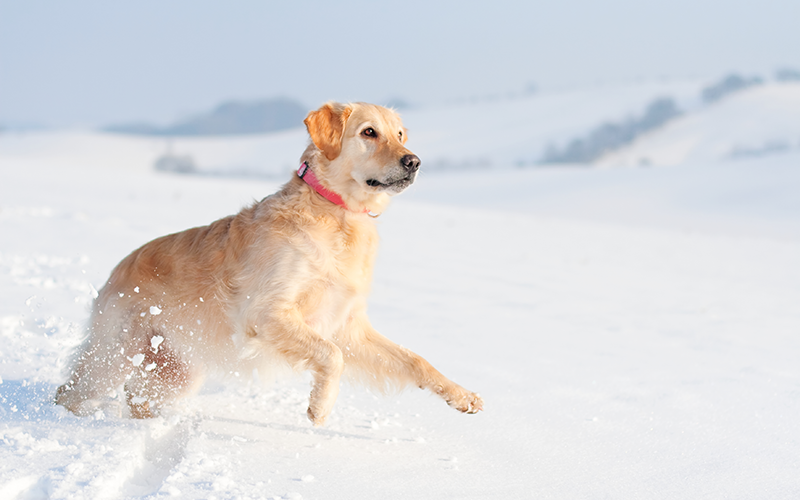Winter may be a wonderland for dogs and pet parents when a few inches of light snow dust the ground. However, when blizzards strike, severe cold and snow can pose serious health and safety risks for dogs of all breeds. And according to weather predictions by the Weather Network and AccuWeather, an active winter is predicted across the northeastern U.S. and harsh conditions are predicted across Canada.
Here are a few essential tips to share with clients to help keep dogs winter-safe:
Protect Against Jack Frostbite
Paws, ears, and tails, like human hands and faces, are susceptible to frostbite. To help protect dog paws, boots in a wide variety of styles are easily found online and in pet stores. In addition to helping tender paws stay dry, dog boots often come with soles, which also provide added traction in icy conditions.
If your dog doesn’t enjoy wearing boots (or needs time to get used to them), remove caked ice and snow from your dog’s feet as soon as possible. As added protection, make sure to maintain good foot grooming. If your dog has long hair, use a trimmer with a plastic guard to keep the hair between the paw pads short (about even with the pad). This will help prevent ice balls from forming between and around the paw pads, which can be painful for dogs. Also, keep your dog’s nails trimmed. Long nails force a dog’s paw to splay out, which increases the odds of snow and ice accumulating between paw pads.
Frostbitten skin may appear reddish, gray, bluish, or white in color. If you suspect your dog has frostbite, seek immediate veterinary care. While you transport your dog, you can carefully warm the affected area slowly using warm, moist towels. Do not use hot water and do not rub or massage the affected area. If you are suspicious of frostbite from a few days earlier, you may notice blistered, scaling, flaking, or blackened skin. In that case, seek immediate veterinary care.
Salt and Chemical Deicers Can Be Toxic
While more people are using pet-friendly deicers in winter, salt and dangerous chemical deicers remain widely used on sidewalks and streets, and have varying degrees of toxicity for dogs, depending on the ingredients and the amounts ingested.
Chemical deicers containing the antifreeze material ethylene glycol are a deadly poison for dogs. As a standard deicing agent found in antifreeze and winter windshield washer fluid, ethylene glycol has a sweet taste that many dogs find irresistible—and it only takes a small amount to cause permanent and fatal damage to their kidneys.
Road salt can cause painful burning to paw pads, and when licked off by your dog, salt can cause irritation and inflammation to the mouth and digestive tract.
After any exposure to salt and chemical deicers, wipe off your dog’s feet with a damp towel. When using chemical deicers on your walkways, driveway or anywhere else around your home, read the labels of products carefully and follow all recommended precautions.
Wind Chill Can Be Deadly
While some breeds are built better than others to withstand cold temperatures, prolonged exposure for dogs to wind chill and cold temperatures can cause fatality from hypothermia. Shorthaired, very young, and elderly dogs are at the greatest risk for problems related to cold exposure. When temperatures drop, keep walks and outdoor playtime to a minimum. Dog jackets can help dogs stay warmer for longer in winter weather, but even so, don’t wait until your dog starts shivering before realizing it’s time to head back indoors.
If your dog must live outdoors, an insulated doghouse is a must for protection against the elements. If you don’t have a doghouse, building one in winter isn’t ideal, but there lots of options online or in stores. When setting up your doghouse, follow these essentials to help keep your dog warm.
A doghouse should be elevated a few inches from the ground to prevent moisture from accumulating inside. Carpeting, a blanket or a padded bed should cover the floor. A doghouse should be big enough for a dog to stand up, turn around and lie down comfortably, but small enough to contain body heat. The doorway should face away from the prevailing winds, with burlap or canvas hung over the opening to act as a door.
Outdoor Dogs Need More Calories
Just as fireplaces need more logs in winter to keep a house warm, outdoor dogs need more calories in winter to stay warm. To ensure your dog’s food intake is meeting its increased energy requirements, speak with your veterinarian about dietary recommendations.
Adequate water is just as important to an outdoor dog’s health. Although people commonly associate dehydration to hot temperatures, cold temperatures can equally cause dehydration. Check your dog’s water supply frequently to make sure it doesn’t freeze. Also, use plastic bowls. In cold temperatures, a dog’s warm, wet tongue can stick and freeze to metal dishes.
Have a warm and pet-safe winter.






